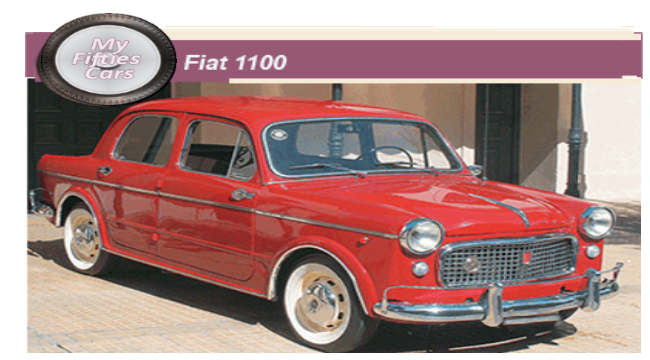 The 1100 103 version introduced in 1955 was Fiat's most successful version of the archetypal family saloon, produced in a number of variants during the Fifties and Sixties.
The 1100 103 version introduced in 1955 was Fiat's most successful version of the archetypal family saloon, produced in a number of variants during the Fifties and Sixties.
The desi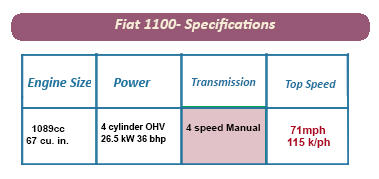 gn team at Fiat had been given a brief to continually update the 1100, with no less than five significant design modifications taking place during the fifties alone.
gn team at Fiat had been given a brief to continually update the 1100, with no less than five significant design modifications taking place during the fifties alone.
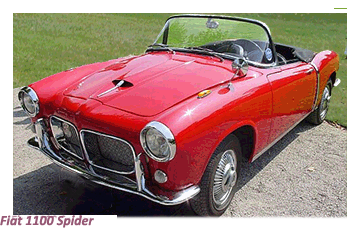 The Fiat 1100, launched in 1954 was a direct descendant of the pre-war Fiat 508 C Balilla 1100, with a sign of the times being that the two models simultaneously remained in production well into the Fifties.
The Fiat 1100, launched in 1954 was a direct descendant of the pre-war Fiat 508 C Balilla 1100, with a sign of the times being that the two models simultaneously remained in production well into the Fifties.
 The new 1100/103 came fitted with the same 1089-cc engine, although with its power boosted to 36 bhp, as well as a new counter-balanced crankshaft and modified carburetion.
The new 1100/103 came fitted with the same 1089-cc engine, although with its power boosted to 36 bhp, as well as a new counter-balanced crankshaft and modified carburetion.
To the motoring media, the Fiat 1100 was nothing more than a 508C with a new grille. Externally this may have appeared the case, although the fundamental difference was that the 1100 had been designed with a monocoque bodyshell.
![]()
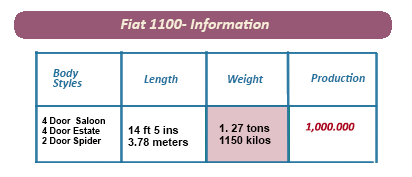 A development that not only reduced the car's body weight by around 100 kilos (220 pounds) but also provided the Fiat design team with almost limitless options.
A development that not only reduced the car's body weight by around 100 kilos (220 pounds) but also provided the Fiat design team with almost limitless options.
Within the first year of launch, Fiat rapidly introduced Estate and Spider convertible versions of the 1100, both of which debuted at the 1955 Geneva Motor Show.
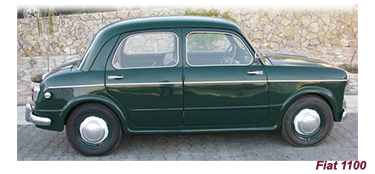 A series of light commercial versions of the Fiat 1100 were introduced in 1955.
A series of light commercial versions of the Fiat 1100 were introduced in 1955.
With their choice of models firmly established, starting from 1956 the new 1100 received numerous updates. Over the years these updates included a wholly redesigned grille, dual colour dressing and even small fin-tails with integral spear-shaped backlights.
The 1100's upholstery was finished in an invitingly pleasant cloth trim, with the option to choose leather. To ensure maximum comfort, the driver and front passenger seats could be independently adjusted.
 With longer journeys now commonplace within Italy and out with its nopad
in the mainland Europe, the need for extra baggage space was met by pulling the squab (back) of the rear seat forward to gain access to some considerable auxiliary luggage area.
With longer journeys now commonplace within Italy and out with its nopad
in the mainland Europe, the need for extra baggage space was met by pulling the squab (back) of the rear seat forward to gain access to some considerable auxiliary luggage area.
![]()
Other " luxuries " that came with the Fiat 1100 as standard included
wind-up windows, electric double-arm windshield wiper, driving mirror, directional indicators recessed into pillars ( something of a trademark with Fiat of the Fifties), interior lighting, clock, two adjustable inside sun visors, map pockets on doors, and a spare wheel recessed into the tail (on the car's exterior).
The 1100 remained in production for thirteen years, evolving steadily and gradually until being replaced by the new Fiat 128 in 1969.
remained in production for thirteen years, evolving steadily and gradually until being replaced by the new Fiat 128 in 1969.
 Despite initial misgiving's that its design was dated, it soon became apparent to Fiat that, by accident or design, with the 1100 they had developed a car that was capable of re-inventing itself, and on almost an annual basis.
Despite initial misgiving's that its design was dated, it soon became apparent to Fiat that, by accident or design, with the 1100 they had developed a car that was capable of re-inventing itself, and on almost an annual basis.
The Fiat 1100 went on to become the quintessential Italian family car, providing spacious, practical and reliable transport for more than one million Italian families.
Take me back to the home page
EU6


